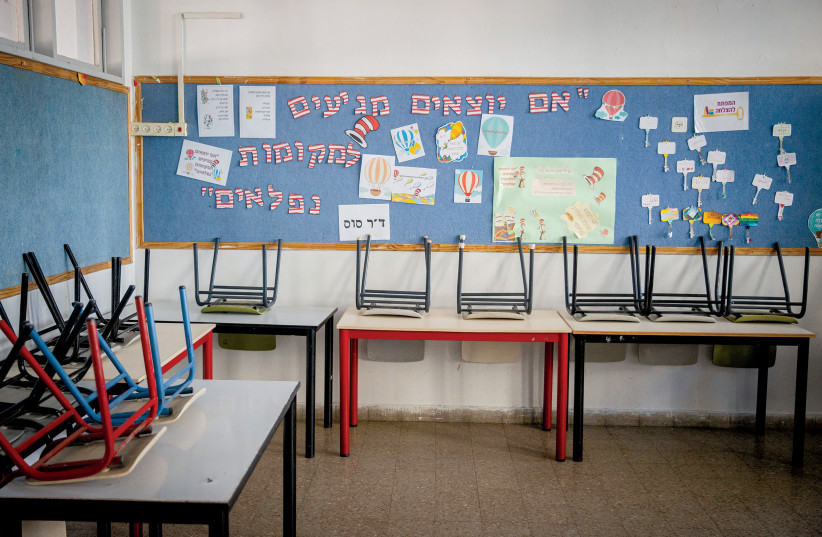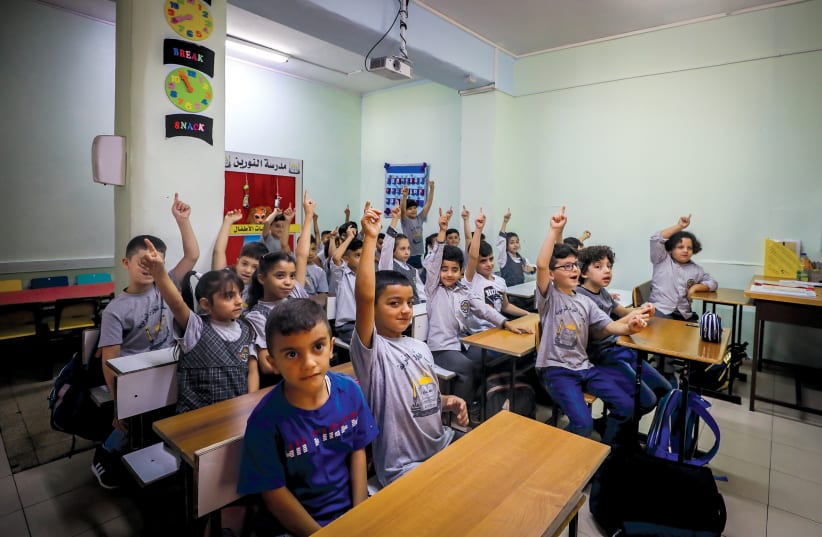The Jerusalem Municipality operates three education systems that are run differently from one another but are all under one management – the education administration, or Manhi. Jerusalem has the largest education system in Israel at all levels – in state secular and religious education, in Arab sector education, and the largest system in ultra-Orthodox education. In all of them, the number of students is significantly larger than in any other city in Israel. The Arab sector includes official and recognized non-official educational institutions, which operate according to the curriculum of the Palestinian Authority. There are also ultra-Orthodox educational institutions under the administration of the ultra-Orthodox education department in the municipality, in addition to a number of education institutions that are not under the supervision of the city – the independent, mostly Hassidic institutions, where, for the most part, the teaching is done in Yiddish. There are also private Arab schools in the city, most of which are under Christians institutions, and some are under the Waqf institutions.
In the state and religious state education, there are 699 schools, with 3,040 classes and 66,159 students. In ultra-Orthodox education, there are 1,164 institutions, with 4,115 classrooms for 105,898 students. In the Arab sector, there are 916 institutions, with 3,724 classrooms in which 93,249 students study. In addition, it is estimated that there are some 25,000 students in several grades in private school education in the Arab sector.
The programs of Jerusalem education
There is a variety of unique programs offered by the Jerusalem education system. For example, the Jerusalem College program makes the academy accessible to high school students from all sectors and populations in the city. In this innovative project, launched two years ago, 1,400 students participated in the program, 600 of them in the each semester during the school year. In the first semester, most of the students who enrolled were from schools with strong populations. In the second semester, students from all sectors took part – special education, Arabs, disadvantaged neighborhoods, and Beit Ya’akov seminary girls. At Safra Square, this is considered a breakthrough.
Another excellent program is Telma, the national program for excellence in English. Now in its second year, a growing number of schools take part.


“There is no other city in Israel that brings social workers into the schools, but we do it.”
Hagit Moshe
Another innovation run by the city’s education administration is the introduction of social workers in the schools. “There is no other city in Israel that brings social workers into the schools, but we do it,” Deputy Mayor and holder of the education portfolio Hagit Moshe proudly stated last year. These social workers are in the schools for both the children and the teachers. This step required a significant additional budget, which was generously approved by the city council, at first in response to the special needs that arose from the corona pandemic but also due to Jerusalem’s ongoing security issues. Moshe pointed that all these initiatives make the Jerusalem education system a trailblazer at all levels and in all sectors, and the goal is to continue and increase them.
Back to figures. The status of the various education streams in the city provide a clear picture of the present situation and the forecast for the years to come. All agree, in the education system and among the political circles on the city council, that in the coming years, the ultra-Orthodox stream will continue to grow, while the state secular one is shrinking. Among the students in secondary schools (grades 7-12), 37% belong to ultra-Orthodox education; 33% to urban Arab education; and 30% to state and state-religious education. On the other hand, in elementary schools, the proportion of ultra-Orthodox students is similar (38%); the proportion of Arab education students is slightly higher (38%); and the proportion of state and state-religious students is lower (24%). Among compulsory kindergarten children, the share of ultra-Orthodox education is particularly high – 48% compared to Arab sector education (28%) and state and state-religious education (24%). The number of ultra-Orthodox children in compulsory kindergartens is particularly high because it is affected by the relatively low number of Arab children, many of whom are not enrolled in compulsory municipal kindergartens. A separate examination of the students of the state education reveals that their proportion decreases accordingly by age: They make up 19% of the high school students in the city; 15% of the middle school students; 12% of the elementary students; and 10% of the children in the compulsory kindergartens.
The analysis of the trends in the last decade shows that the most significant change occurred in the Arab sector education, where there was a 126% increase in the number of students. This change is due to an increase in the Ministry of Education’s recognition of private Arab schools in Jerusalem as “recognized non-official institutions,” construction of new classrooms that increased the capacity of the schools, and natural proliferation. During that period, the number of students in ultra-Orthodox education increased by 30%; and in state and state-religious education, there was a 12% decrease.
Just before the start of the school year, the Ministry of Education published a list of the 335 high schools that won awards for their achievements in the social and academic fields in the 2015 academic year. The selection of the winning schools was based on a series of indicators in the values, social and academic fields, as well as in accordance with the rate of improvement in the schools. This distinguished list included 25 educational institutions in Jerusalem, compared to 16 schools last year. The schools awarded are: the Municipal High School Rene Cassin; Jerusalem Youth Kiryat; Comprehensive Denmark; Studio T for the arts; Pisgat Ze’ev yeshiva; The High School near the University (Leyada); Horev High School Yeshiva; Amalia Midrasha for girls; public school Pisgat Ze’ev; Keshet in Alice Sligsberg; Tech AMIT Youth Center; The experimental high school (Nissuyi); Boyer, Zvia Ulpana Jerusalem; The Israeli High School for Sciences and Arts (Yasa) Eretz Hazvi; Beit Yaakov Seminary; Academy of Music; Himmelfarb; Ziv High School; Nevet Israel; Sudbury Jerusalem; and Tal Ramot Ulpana.
Another challenge faced by Manhi is the shortage of classrooms, which has been a problem for the past 20 years and even reached the Supreme High. However, despite the huge shortage of study spaces in the city, in 2022 only 124 new classrooms were built compared to 261 last year. The amazing figure is joined by an equally surprising fact: In 2018, the municipality submitted an affidavit to the High Court of Justice stating that the city lacks more than 3,000 classrooms. That year, Moshe Lion was elected mayor. Since then, in every interview on the subject he claims that during his time there was a “building boom.” This is repeated again and again in the official announcements that Safra Square puts out to the media. So it is true that hundreds of classrooms are being built a year; but despite the long time that has passed since the declaration, it turns out that the gap remains almost the same. Jerusalem still lacks more than 3,000 classrooms, but only part of it stems from the natural growth rate in all sectors of the city.
In the coming weeks, we will provide a map of the education system in the city with all its various components and examine the difficulties and challenges faced by each sector. In addition, we will present a number of characteristics of the schools that have departed, at varying degrees, from their fixed frameworks and offer students – and their parents – a groundbreaking education system that is innovative and adapted to the challenges of the 21st century and its technological advancements. ❖
This is part I in a new series on education in Jerusalem.
